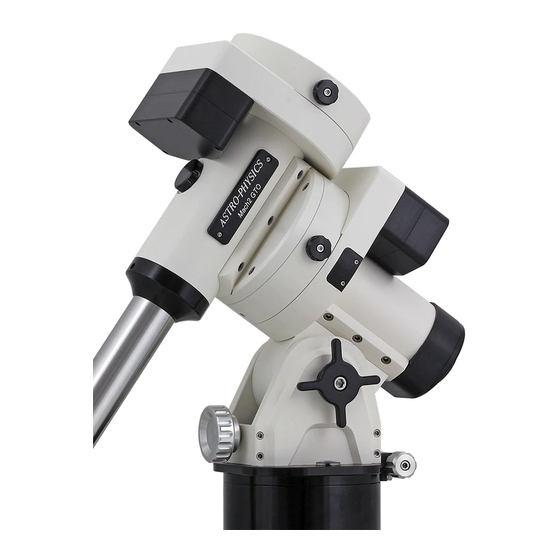ASTRO-PHYSICS 900 German Equatorial Manuale - Pagina 9
Sfoglia online o scarica il pdf Manuale per Accessories ASTRO-PHYSICS 900 German Equatorial. ASTRO-PHYSICS 900 German Equatorial 12. Polar alignment telescope and illuminator (pasill)
Anche per ASTRO-PHYSICS 900 German Equatorial: Manuale di avvio rapido (2 pagine), Manuale (3 pagine)

Balancing Your Telescope: For proper operation, the telescope must be adequately counterbalanced. Start by
balancing the tube assembly.
1. Tighten the four R.A. axis clutch knobs.
2. Loosen the four Dec. axis clutch knobs (about ¾ to 1 turn) so that the telescope moves freely about the declination
axis. Be careful! If your telescope is significantly out of balance, it may swing rapidly in the out of balance direction.
3. Position the R.A. axis so that the counterweights are in their "lowest" position i.e. the declination axis assembly is in
the meridian (this is the usual way that German equatorial are depicted, as shown in the diagram page 2).
4. Loosen the tube mounting rings and slide the tube up and down for balancing. This is best done with the tube in the
horizontal position.
5. The scope is balanced when it stays put (does not move) with the clutches loose and movement back and forth
about the declination axis has the same feel in both directions.
6. Now, tighten the declination axis clutch knobs and position the telescope horizontally and the declination axis
horizontally. The center of the counterweights is now the same height as the middle of the tube.
7. Loosen the R.A. clutch knobs. Again be careful, because if your scope is significantly out of balance it may swing
rapidly in the out of balance direction!
8. Move the counterweight(s) up or down to achieve balance in R.A. Again, movement back and forth about the R.A.
axis should have the same feel in both directions.
9. Try to anticipate any balance problems due to the extra weight of diagonals, heavy eyepieces, finders, solar filters,
etc. If the scope moves by itself, when the clutches are loose, then the scope is not counterbalanced adequately.
A small amount of imbalance is permissible and even desirable for astrophotography and imaging. When the
mount is properly polar aligned, it is possible to take unguided astrophotos for several minutes without trailed star
images.
OPERATION OF THE QUARTZ MICRO-DRIVE CONTROLLER
The push button controller contains all the circuitry for driving the two motors. It will be operational when attached to
both the motors of the mount and a power source. Power requirements are 12 to 16 volts dc, 800ma. This can be
supplied from a battery or an AC to DC converter. If the voltage falls below 10 volts, the power light will go out and the
motors will quit running.
A very accurate quartz clock specifically calibrated for the drive gear is an integral part of the controller. The calibration
is made to the King sidereal rate, which compensates for atmospheric refraction over a large part of the sky. With this
tracking rate, it is easier to maintain critical guiding at high power. For the most sophisticated tracking of celestial
objects, the controller has a built-in provision for attaching a ST-4 or ST-6 CCD imaging camera/autoguider. Using the
autoguider function, it is possible to take long exposure astrophotos totally unattended. You can walk away from the
setup to enjoy other observing activities while your astrograph is in operation.
The controller contains circuitry for storing the periodic error of the worm. Depending on how well the initial guiding was
done during the record period, a very significant increase in guiding accuracy can be expected.
CABLES: Place the DC power cord into the phono plug outlet of the R.A. motor box. Plug the short length of the "Y"
cable into the R.A. motor box and the long length into the Dec. motor box. Complete the cable assembly by
joining the control box cable to the "Y" cable. The control box and motors are designed to work at 12 volts DC.
Suggested power sources include: portable rechargeable battery pack, auto battery, or power converter for
110 volts with a minimum output of 800ma. at 12VDC.
DRIVE ROTATION: If you are operating the 900 mount north of the equator, the HEM (hemisphere) switch must be set to
"N". If south of the equator, set the switch to "S".
- 9 -
